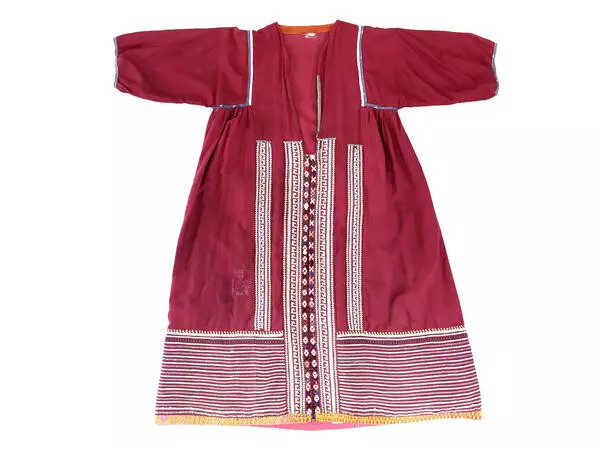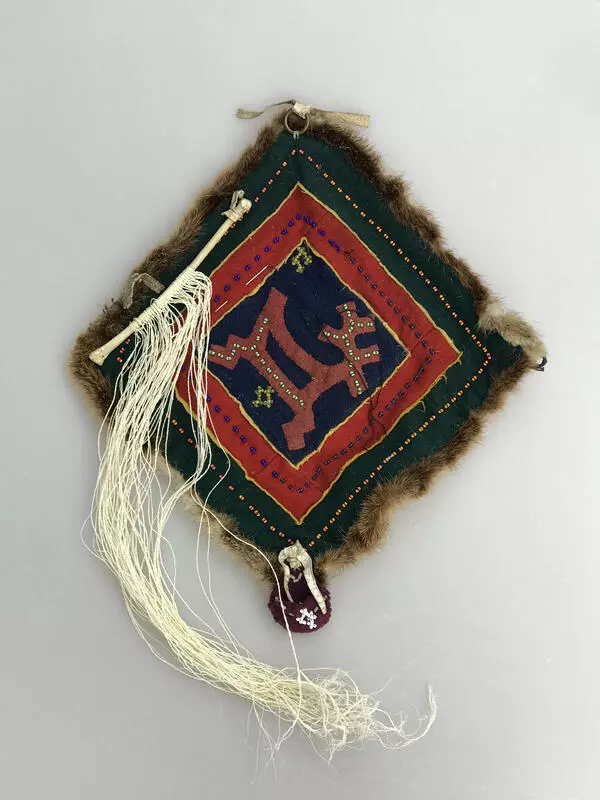For the northern peoples, nabirushka is a small birch bark basket, into which wild berries are collected. Berries do not crumple and stay fresh longer in a basket like this. The volume of a traditional nabirushka is two or two and a half liters. Large nabirushkas are not popular as the full basket becomes heavy, and it is hard to carry it.
The nabirushka from the museum was made at the end of the 20th century in the village of Kazym in the Beloyarsky district. The round top of the basket holds its shape thanks to a hoop made of a bird cherry twig, which is attached to the sides with a nylon thread. The traditional Khanty ornament “wood grouse hen” is depicted on the sides of the nabirushka — it was scraped out according to an old technique.
The Khanty and Mansi believe that every person has several souls. Women have four souls and men have five ones. Wood grouse hen is one of the souls. According to the legend, this bird flies to a person when he or she falls asleep, brings dreams, protects the person’s soul from evil forces.
The Khanty people always decorated children’s cradles with the “wood grouse hen” ornament. They believed that the guardian bird needed to get used to the child in order to follow him or her in the future, wherever he or she went.
Traditionally a nabirushka is made of birch bark measuring forty-five by thirty-five centimeters. It is bent into halves, the edges are cut off, and then the sewing process begins. To get a good birch bark, one should choose the tree carefully. It should have a straight trunk, and there should be as few black spots on the bark as possible. After making small incisions, the master manually removes the birchbark from the tree in a circle.
The material is gathered either in autumn before the frost, or in spring, during the ascent of sap in trees. At other times, the bark “sticks” to the trunk. Birch bark is cleaned from the outside, then boiled in a cauldron for 10-12 hours.
Birch bark pieces are stored, rolled up so that they do not dry up and do not twist. Birch bark and products sewn from it are kept in dry places at room temperature. Birch bark can become damp or moldy from long contact with moisture.
The nabirushka from the museum was made at the end of the 20th century in the village of Kazym in the Beloyarsky district. The round top of the basket holds its shape thanks to a hoop made of a bird cherry twig, which is attached to the sides with a nylon thread. The traditional Khanty ornament “wood grouse hen” is depicted on the sides of the nabirushka — it was scraped out according to an old technique.
The Khanty and Mansi believe that every person has several souls. Women have four souls and men have five ones. Wood grouse hen is one of the souls. According to the legend, this bird flies to a person when he or she falls asleep, brings dreams, protects the person’s soul from evil forces.
The Khanty people always decorated children’s cradles with the “wood grouse hen” ornament. They believed that the guardian bird needed to get used to the child in order to follow him or her in the future, wherever he or she went.
Traditionally a nabirushka is made of birch bark measuring forty-five by thirty-five centimeters. It is bent into halves, the edges are cut off, and then the sewing process begins. To get a good birch bark, one should choose the tree carefully. It should have a straight trunk, and there should be as few black spots on the bark as possible. After making small incisions, the master manually removes the birchbark from the tree in a circle.
The material is gathered either in autumn before the frost, or in spring, during the ascent of sap in trees. At other times, the bark “sticks” to the trunk. Birch bark is cleaned from the outside, then boiled in a cauldron for 10-12 hours.
Birch bark pieces are stored, rolled up so that they do not dry up and do not twist. Birch bark and products sewn from it are kept in dry places at room temperature. Birch bark can become damp or moldy from long contact with moisture.







